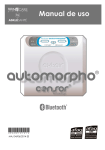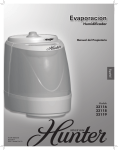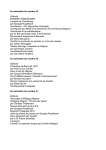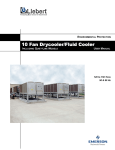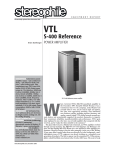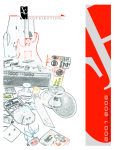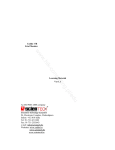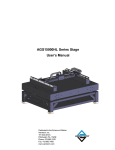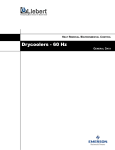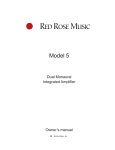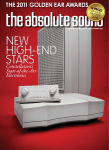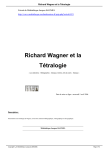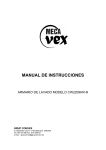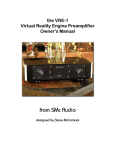Download VTL TL7.5 Linestage and Control Center
Transcript
20 G 0 Awold 2 ar en d E ar Electronically Reprinted from Issue 139 equipment D E C E M B E R 2 0 0 2 / JA N U A RY 2 0 0 3 report VTL TL7.5 Linestage and Control Center Arthur S. Pfeffer he classy TL7.5 is VTL’s first flagship linestage for more than a decade, aiming to complement the awesome MB1250 Wotan and MB750 “Brunnhilde” power amps. Indeed, the 7.5 uses such Wotan technology as separate, external power supplies for each amplification stage. With the 7.5, VTL not only puts in for state-of-the-art status but also makes the point that VTL is not just a power-amp company. In reality, its moderately priced tube preamps have always been prized by a coterie of finicky music and audio professionals. At ten grand, and not moderately priced, the TL7.5 doesn’t just poshly upscale the single-chassis TL 5.5, though it retains basic VTL traits like dual-mono design and the trusty T 12AX7 tube—this baby is the company’s first hybrid. According to the Talk (we’ll see about the Walk), the 7.5’s tube gain stage offers linear voltage amplification with almost no feedback, while its MOSFET output stage offers high current capability with low output impedance. Nevertheless, the 7.5 had to overcome my taste for all-tube preamps, established over many years by the likes of Dynaco, ARC, ConradJohnson, Herron, and VTL itself. When an all-tube manufacturer goes solid-state, tube-lovers get nervous. But this is a totally serious, totally thought-out, totally handsome effort. The TL7.5 doesn’t break with VTL’s past technical and sonic achievements but builds upon them, blazing a new trail toward an old goal. Luke Manley and his engineering team aimed the 7.5 at both the audio purist and the home-theater fan, two species often fused in a single befuddled crossbreed—myself, for example. Befuddled because home theater needs complex switching, input and signal routing, and loudness management, all anathema to the sonic purist seeking to abolish every switch and control from the signal path. Folding a high-end control center into a high-end linestage is a daunting challenge. VTL’s solution is, to start with, a two-box design. Box A is the “clean” audio box, where the sound goes in and comes out. For low noise and an unobstructed signal path, AC power and all control functions including the display have been banished, physically and elec- To subscribe to the absolute sound, call 888-475-5991 (US), 760-745-2809 (outside US) or visit www.theabsolutesound.com. $42 for six issues in the US; $45 Canada, $75 outside North America. Posted by permission from Absolute Multimedia, Inc. All rights reserved. Any unauthorized duplication of this article is strictly prohibited. equipment report trically, to Box B, the power supply and control unit. Box B digitally administers inputs, volume, balance, and signal polarity. All the yucky stuff takes place way off-premises in the “dirty” box, which sees no audio signal. The only signals it sends to the sound box, besides power, are non-digital low-voltage DC control pulses that operate a bank of relays. These select the inputs and attenuator-resistor values that yield the desired volume and channel balance. The sound box contains no digital circuitry, no rotary potentiometers, and of course, no 120 VAC. Its total tube complement is two 12AX7s on a shockmounted circuit board. The music signal “sees” only those contacts that route each channel through the appropriate volume resistors, plus an output fuse. Even in “dirty” Box B, a single dial, a rotary optical encoder under software control, serves every needed function. (By the way, the TL7.5 is very solidly fabricated, with heavy-gauge build quality and top-grade parts. Fully packed, it weighs 90 pounds. Good thing it’s in two pieces.) Now this is something different: A remote computer running a separate purist preamp. A passive preamp, an alternate approach to purity, has noisy controls but no gain. Box A, an “inactive preamp,” has gain but no noisy controls. This is how the 7.5 combines an uncontaminated amplification path with a control-freak’s banquet of switching and diddling functions. It even boasts fully differential audio circuits for allthe-way-through balanced operation, not just at inputs and outputs. Standard RCA coax connectors are also provided. Designed to serve as an audio-only control center for an entire home-theater system, the 7.5 can automatically turn on and off any trigger-equipped power amp, programmed through Inputs 1-4. The 7.5’s 13 faceplate and 16 remotecontrol buttons inter-operate ingeniously to do everything you need—but at first, in programming play modes and settings, keep your user’s manual handy! Real-time operations are generally easy and intuitive. Now for the sound. Advance press, frankly, set me up to expect the 7.5 to breathe heavily, flex its muscles, brandish its weaponry, blow me back, knock my socks off, and do all the macho stuff its price and appearance predicted—in other words, to sound grandiose and spectacular. It did, all right, but behind the scenes. Up front, it sweet-talked me. It is the easiest preamp to listen to I’ve heard in my system. It made the music effortless, as in live, while socking me with dynamic punch and captivating me with sharp image definition, fine resolution, and the other surgical attributes ears greedy for inner detail require. Antiseptic? Forget it. Analytical, etched? Never. The 7.5 integrates rather than deconstructs the elements of music. Brute strength? Yeah, definitely, and airily dimensional spaces, too, but the big story is music that flatters the ears. The 7.5 simply sounds right, right in the critical midrange and right—the same right, not different “rights”—from top to bottom. As a reproducer of music, the 7.5 fulfills its promise, truly synthesizing the best features of tubes and, um, those other things. I was relieved to discover that I knew its sound before I turned it on, because it is a replica of the MB 750 (pure tube) power amp in linestage form, as if cloned from the amp and carrying its genes for delicacy with power, clean and silky textures, gigantic spaces densely populated with rounded images, and uninhibited dynamic intensity. It retains VTL’s tight dual-mono imaging focus, adding the most grain-free textures VTL, maybe anyone, has yet extracted from a preamp. Music or speech hangs suspended before ultrablack backdrops, and details from the rasp of a jazz trumpet to the latching of a distant gate in a surround-sound movie are delivered effortlessly into your listening space. “Effortlessness,” sheer auditory comfort, is the 7.5’s hallmark. Without masking recording deficiencies, softening edges, or limiting dynamics, it caresses the ear as live music in a good hall does. You enjoy a full measure of dramatic excitement while relaxing into the swells of sound, unperturbed by 2 • THE ABSOLUTE SOUND • 139 aggressiveness or edge contributed by the linestage itself. It even seems to caress the spaces between instruments and the silences between notes, if that’s not too extravagant a conceit. Of course, a component has to reproduce the spaces, i.e., have ultra-fine resolving power, before it can “caress” them. A favorite LP illustrates this “comfortable spaces” effect: soprano Victoria de los Angeles in Spanish zarzuela arias [EMI HMV ASD 2415]. Imagine a panoramic stage in a large theater where a gorgeous voice is centered in front of an orchestra with a small chorus in the rear. Airy atmosphere circulates freely among, above, and behind them and floats out into the room. In recordings with a soloist backed up by an orchestra, chorus, or other large ensemble, the 7.5 expands stage depth by placing the centered solo closer to the front than usual and pushing the ensemble farther back. Some preamps move the entire stage either forward or back, but the 7.5 offers a most convincing reproduction of the actual stage layout. The vocals in Sera Una Noche [MA 052, CD] also hover in space, attended by bandoneon, clarinet, and other sinuously textured instruments. All emit flowing tones with fluidly articulated edges and interfaces, palpable but unthreatening presences whether of performers here or listeners there. In the DCC Everest LP of Uirapuru by Villa-Lobos [LPZ 1003] the 7.5’s bass power and speed allow me to hear clearly—and with body and ambient air— the usually obscured soft, spooky, sustained string bass note, incorporating louder “bumps,” in the right rear of the stage, supporting a centered flute solo near the beginning. The preamp parts the air serenely for this piece’s many jolting bass- and kettle-drum shocks. The envelope of percussive attack and decay has remarkable accuracy and emotive force. Same is true of the gutsy bass guitar in Rickie Lee Jones’ “Cycles” [It’s Like This; Artemis 751054, CD]. Would Rickie Lee be entirely happy if she knew how intelligibly the 7.5 transmits her slurred words? No doubt about what equipment gospel communicator Aaron Neville is saying in “I Bid You Goodnight” [Warm Your Heart; A&M 215354, CD], where each of the back-up voices, including the resonant bass, has its own distinct harmonic and spatial identity. Like the MB 750, the 7.5 reproduces strings, loud or soft, wonderfully well, with a light yet incisive attack and feathery sustained tone. The word “luscious” came to mind as I listened to an inauthentically but beautifully stringrich performance of Haydn’s Symphony #100 [Vanguard SRV 109SD, LP, or SVC 14/16, 3 CDs]. The 7.5 sheds new light on mysterious imaging flaws in the fine old Aubort/Nickrenz Vox recording of Gershwin’s Concerto in F in Classic Records’ DAD transfer [DAD-1018, 2 DADs]. Despite a spectacularly truthful rendering of St. Louis’ Powell Hall, its cubic acres wall-to-wall with instruments, the solo piano in the DAD flips and fragments, oh so clearly, between right and left. The 7.5 tells me that the old LP [Vox QSVBX 5132] was more successfully mixed. In both media, the 7.5 combines gleaming tinkles of glockenspiel and triangle with ripe, powerful bass-drum and tympani bashes. Gershwin’s jazzy syncopations and swinging percussion show off how great this preamp is at rhythmic pace, partly because it doesn’t bury in noise the tiny contours of attack and decay. Bass agility and support are evident in Virgil Fox’s low-bass-rich organ recital [Laserlight 15313, CD]. Not only are pedal tones full-throated, but the layout of the pipes is apparent, with a cohesive, lucid topto-bottom organ sound and recreation of Garden Grove Community Church’s vast spaces. Now let’s talk about pair-bonding. VTL claims the 7.5’s 25-ohm output pair-bonds with any amp through any length of cable. I can report that the 7.5 drives Herron M150s, unusually musical, tube-like solid-state amps, to near perfection through 25-foot cables. But it is in tandem with its genetic ancestor the MB 750 (via 35-foot cables!) that the preamp’s musical potential is utterly fulfilled. The 7.5 was designed using the Brunnhilde and big daddy Wotan, and this family reunion is sonic Valhalla. The 7.5 and my Brunnhildes leapt into each other’s embrace—fraternal or something more provocative?—and snapped into a “right” tonal and spatial focus that, in my system, neither quite achieves without the other (nor does the TL 5.5/750 combo, enchanting though it was). I haven’t heard the 7.5 with Wotans, but if size matters, well, you take it from there. Thom Rotella’s rock band [DMP GOLD-9001, CD] shows off the 7.5’s superb dynamic tracking and rhythmic resolution of multiple percussive and plucked notes and beats. In “Bring on the Night,” juxtaposed loud and soft notes of drum and bass guitar don’t smear but emerge discretely in packets of time and space. Likewise Blue Rodeo’s Nowhere to Here [Discovery 77024, CD], where the sudden silence after the huge climax that ends “Save Myself” gives way immediately to the soft burbling of “Girl in Green” with no trace of blur. There’s no type of music or speech that the 7.5 could not do justice to: symphonic, chamber, rock, vocal, jazz, and movies from the intimate to the gargantuan. The 7.5 resolves those fleeting wisps of the performer and the instrument, and ignores no significant spatial cues. Expect to hear instrumental and vocal images with ample body and bloom all the way to the rear of the stage and the corners as well. The 7.5 accurately catches the “signature” of every recording site and sometimes, with an especially good minimally miked recording from Reference, Verve, Living Stereo, Mercury, etc., captures the “grain” of the air in the hall, not electronic grain but the unique atmosphere at the moment of recording (it’s the sudden discontinuity in this grain that can make tape splices annoying). The 7.5 can project or disperse hall sound out into the listening room, enhancing the Alón Circe’s similar penchant for two-channel envelopment. The 7.5 defines stage depth not so much by layers as by individual instruments. I loved its cozy yet spacious presentation of Johnny Hodges’ “I Didn’t Know About You” and “Cool Your 3 • THE ABSOLUTE SOUND • 139 report Motor” [Blues A-Plenty; Classic Records/ Verve MGVS 68358, LP], the first a small group number and the second a full band. Fabulous image solidity and stability in the sax, trumpet, piano, bass, and drums here. An Aña Caram track, “Viola Fora de Moda” [Rio after Dark; Chesky JD-28, CD], scatters soft, eerie jungle flutterings and whistles all around a deep studio acoustic. The preamp exposes a few formerly concealed beaks and feathers in the foliage. Because of the TL7.5’s exceedingly high not-thereness quotient, its sonic failings are harder to identify than its strengths. At times, I detected an extra warmth or midbass emphasis, but in the end was never able to pin it on the preamp. It came and went with individual recordings. Classic Records’ Living Stereo classical LP reissues are slightly bass-boosted, and the 7.5 renders some of them with what seems an extra bass prominence but others with precisely the right and expected proportions. My old favorite, Rimsky-Korsakov’s Tsar Saltan [London CS 6012, LP], likewise has the bass warmth typical of the ffss series, but the 7.5 depicts it in perfect balance, almost as if intelligently compensating for the boost. I had an identical experience tracking down a slight silvery glitter in highvolume highs, present in a few recordings but not in most. Bottom line: The 7.5 candidly exposes what is in the recording or in my cartridge’s VTA and, by respecting each recording’s inherent balance, calls attention (good-naturedly) to subtle frequency and texture variations. This is the inevitable tradeoff in a revealing component. Nevertheless, the 7.5’s ability to illuminate the stage implies a conscious design effort to counter the “dark” label applied to some VTL products. The 7.5 certainly enjoys a brighter and livelier character than its predecessors, but the glow happily emanates from within the music. Listeners who like their VTL gear tend, I believe, to live with it, and with their other components, for a long time. The brand appears to attract what founder David Manley called “audiomusicophiles,” and the company’s values equipment report stress long-term musical satisfaction at a purchase price typically below that of comparable equipment. The TL7.5 is no departure in this regard. Its level of sonic performance, engineering, and construction actually make it a bit of a bargain even at its exalted price. In a class by itself? In Control Centers for Home Theater with State-of-the-Art Sound, quite possibly. Among audio-only preamps, for those who enjoy the good fortune to command a good fortune in a bear market, it must be included on any short list. Like VTL’s power amps, the TL7.5 will perhaps appeal most to listeners who: 1. Listen to complete musical works or concerts at one sitting; 2. Hear live music often; 3. Hear music in their heads; 4. Need to hear some music every day; 5. Can identify instruments and types of voices by their sound; 6. Don’t expect to trade up every few months; 7. Appreciate the differences between LP and CD or CD and SACD; 8. Have coherent, well-balanced audio systems mingling few brands and sonic flavors; and 9. Aren’t lured by higher snob cachet or glitz factor. Most such listeners will shop contentedly among the enticing array of suitable linestage candidates with four-figure price tags. For those who can go to five, the TL7.5 may very well be the short list. & S P E C I F I C AT I O N S Linestage preamplifier with remote control Gain: 20dB Output level: 30V maximum Input impedance: 50k/ohms (20k/ohms minimum) Output impedance: 25 ohms (maximum 150 ohms @ 10Hz) Dimensions: Control chassis—17.5 x 4 x 17.5 inches; Audio chassis—17.5 x 6 x 17.5 inches Weight: 75 lbs. A S S O C I AT E D E Q U I P M E N T Herron VTPH-1 phono stage; Herron VTSP-1a and VTL TL5.5 linestages; VTL MB750 Reference and Herron MB150 amplifiers; Clearaudio/Souther Reference Turntable/arm; Benz Ruby 2 cartridge; Walker Power Motor M A N U FA C T U R E R I N F O R M AT I O N VTL Amplifiers, Inc. 4774 Murietta Street, Suite 10 Chino, California 91710 Phone: (909) 627-5944 www.vtl.com email: [email protected] 2002 Golden Ear Awards Drive; Nordost SPM Reference and Acarian Black Orpheus speaker cables; Pioneer DVL919 DVD/CD player; Monarch DIP 24/96 jitter filters; VTL TDAC-2 DAC; Discovery and Walker power cords; Herron, Discovery, and Nirvana interconnecting and digital cables; AudioPrism Quietline AC filters Arthus S. Pfeffer • VTL TL7.5 Linestage: $10,000 lending traditional tube virtues with digital technology, VTL’s new upscale linestage delivers luscious stateof-the-art two-channel sound plus hometheater audio management. A tube-solidstate hybrid, a first for VTL, the handsome, massively constructed 7.5 ingeniously restricts all switching, control, and display functions to a separate power-supply chassis, guaranteeing a short, uncontaminated signal path in the “clean” audio chassis. Quiet relays and resistors stand in for noisy rotary pots, and software replaces switches. The result is exceptional neutrality and purity, imaging precision, and B dynamic freedom—gain without pain. Harmonic texture is relaxed and ingratiating, top-to-bottom consistency striking. The unconventional two-chassis engineering results in tube-like sweetness, effortless dynamics, and a brightly illuminated soundstage. The 7.5 has the subtlety to handle chamber music and the dynamic clout for heavy rock and heavy Wagner. Superb speech and soundtrack reproduction for home theater. The 7.5 mates superlatively with VTL’s own MB 1250 and MB 750 amps but, with its very low output impedance, easily drives virtually any other amp as well. Myriad features include a dedicated power supply for each fully differential gain stage, trigger AC control of connected components, remote balance control and input selection, input volume offsets, signal polarity reversal, fully balanced operation, dualmono circuit design, and a receptor for AMX, Crestron, and other control systems. Programming and setup are a little tricky and require attention to the manual, but normal operation is fairly straightforward. The 7.5 is destined to become a classic luxury preamp for very serious music lovers.





